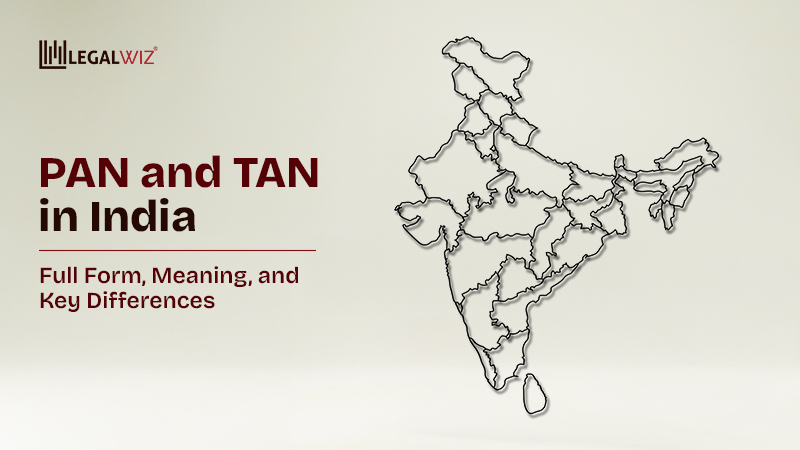How to Register a Company in India: A Step-by-Step Guide
Every successful business begins with an idea—a solution to a pressing problem, a vision for innovation, or a passion that drives change. However, transforming that idea into a legally recognized business requires registering a company in India, a process that many find daunting.
Navigating legal formalities, documentation requirements, and compliance obligations can feel overwhelming, especially for first-time entrepreneurs. Questions like how to register a company in India, what is the cost of registering a company in India, and which business structure is best are common concerns that arise during the process.
This guide simplifies how to register a company and provides a structured approach to company registration in India, ensuring that you have all the necessary information in one place. Whether you are a solo entrepreneur, a startup founder, or a small business owner looking to expand, this step-by-step guide will help you register your company efficiently and confidently.
Why Register a Company in India?
Registering a company is more than just fulfilling a legal requirement—it provides a strong foundation for business growth and ensures long-term sustainability. Here are some of the key advantages:
1. Legal Recognition
A registered company becomes a separate legal entity, which means it can enter into contracts, own assets, and incur liabilities in its own name.
2. Limited Liability Protection
Incorporating a company protects the personal assets of the owners from business debts and financial risks.
3. Enhanced Credibility and Trust
Customers, investors, and financial institutions view registered businesses as more reliable, increasing opportunities for funding, partnerships, and growth.
4. Access to Funding and Investment Opportunities
Venture capitalists, angel investors, and banks prefer investing in registered businesses, making it easier to secure funding for expansion.
5. Structured Business Growth and Compliance
Registering a company ensures compliance with government regulations, making it easier to scale operations while staying legally protected.
What You Need to Know Before Registering a Company
Before registering a company in India, it is important to choose the right business structure. The most common types include Private Limited Companies (PLCs), One Person Companies (OPCs), and Public Limited Companies. While this guide primarily focuses on the registration process for a Private Limited Company, the key considerations discussed here apply to other company structures as well, with certain procedural variations.
1. Minimum Shareholders and Their Residential Status
Every company requires a minimum number of shareholders (also known as subscribers to the memorandum of association). The number varies based on the type of company:
- Private Limited Company – At least two shareholders
- One Person Company (OPC) – One shareholder
- Public Limited Company – At least seven shareholders
There are no specific nationality restrictions for shareholders. Since Indian resident shareholders are not mandatory, a Private Limited Company can be 100% owned by foreign nationals.
To understand the eligibility and requirements in detail, read our guide on who can become a shareholder in a company.
2. Directors (Executive & Non-Executive) and Their Residential Status
A company’s directors are responsible for decision-making and regulatory compliance. The requirements for directors are:
- Private Limited Company – At least two directors
- Public Limited Company – At least three directors
- One Person Company (OPC) – At least one director
At least one director must be a resident of India, meaning they must have stayed in India for at least 182 days in the previous financial year. Both executive (actively managing the company) and non-executive (advisory role) directors can be appointed.
For a detailed explanation of the eligibility and appointment rules, refer to our guide on minimum directors in private company
3. Objective of the Company (Scope of Business Activities)
Defining the main objective of your company is essential, as it will be mentioned in the Memorandum of Association (MOA). The business activities must align with the Companies Act, 2013, and should not be ultra vires (beyond the scope of legal authority).
To understand how to draft and define this section correctly, refer to our guide on what is the main object in MOA of a company.
Clearly outlining your business objectives ensures compliance and helps in obtaining relevant licenses and approvals in the future. If you plan to expand your business activities later, you may need to amend the MOA.
4. Structuring the Name of the Company
The company name must comply with the Companies (Incorporation) Rules, 2014, and should be unique, relevant to your business, and free from any restricted terms. The structure typically follows:
[Unique Name] + [Business Activity/Industry] + [Private Limited / Limited]
For example, TechNova Solutions Private Limited or GreenHarvest Agro Private Limited.
Before applying for name approval, check for name availability on the MCA portal and ensure it does not infringe on any registered trademarks. You can also refer to our detailed guide on How to Decide Company Name to understand the naming rules, restrictions, and approval process.
5. Capital of the Company (Authorized & Paid-up Capital)
Capital plays a crucial role in structuring your business. It is categorized as:
- Authorized Capital – The maximum amount of capital the company can raise. The minimum authorized capital for a Private Limited Company is ₹1 lakh (though no upper limit exists). To understand this in detail, read our guide on what is authorized capital of a company.
- Paid-up Capital – The actual amount invested by shareholders. There is no minimum paid-up capital requirement for Private Limited Companies. However, if you want to understand the financial threshold and compliance norms in depth, read our article on minimum paid up capital for private company.
While there are no strict rules on capital structuring, a well-planned capital structure can help in future fundraising and investor relations. Read the difference between Authorized Capital and Paid-up Capital here.
6. Registered Office Address
A company must have a registered office address in India, which will be used for official correspondence with regulatory authorities like the MCA (Ministry of Corporate Affairs) and the Income Tax Department.
- The address can be a commercial or residential location (not an empty plot or virtual office). To understand the legal conditions and documentation, read our guide on use residence as registered office.
- The address must be supported by valid proof such as a utility bill (electricity, water, or gas bill), Rent Agreement (if applicable) and an NOC (No Objection Certificate) from the owner.
This address can be changed later by filing the appropriate forms with the MCA.
7. Compliance, Reporting, and Filings
Registering a company is just the first step; maintaining compliance with legal requirements is equally important. After incorporation, businesses must complete a series of regulatory filings to remain in good standing with the Ministry of Corporate Affairs (MCA) and tax departments.
Some of the essential post-incorporation compliances include:
- INC-20A Filing (Declaration of Business Commencement):
Every company with share capital must file Form INC-20A – Declaration for Commencement of Business with the MCA before starting operations. This filing confirms that the company has received share capital from its subscribers and is ready to commence business. - Director KYC (DIR-3 KYC):
Directors are required to verify their credentials annually through the MCA portal. Also check out our detailed guide on DIR-3 KYC process and compliance requirements which explains the form, due dates, and penalties for non-filing. - Annual MCA Filings – AOC-4 and MGT-7:
Every Private Limited Company must submit its audited financial statements and annual return each year. Learn how to prepare and file these reports correctly in our blog on AOC-4 filing for Private Limited Companies and Form MGT-7 overview, purpose, and key deadlines. - Income Tax Filings:
Companies must file annual income tax returns and quarterly TDS statements to comply with the Income-tax Act. Simplify compliance with LegalWiz’s Income Tax Return Filing in India, designed to make business tax filing quick and seamless. - GST Filings:
GST-registered businesses must file periodic returns (GSTR-1, GSTR-3B, etc.) to report sales, purchases, and tax payments. You can simplify this process with expert help through our Online GST Return Filing service. - Board Meetings and Resolutions:
Companies are required to hold board meetings and general meetings at prescribed intervals, documenting decisions through formal resolutions.
The following resources explain how board decisions, resolutions, and meetings are documented and governed under company law:
For a complete breakdown of recurring and event-based compliances that apply after incorporation, explore our comprehensive guide on post-incorporation compliances for Private Limited Companies.
8. Documentation Required for Registration
To register a company in India, you need to submit certain documents to the MCA. The key documents include:
- Identity Proof of Directors & Shareholders: Self-Attested PAN card (mandatory for Indian nationals), Self-Attested passport (for foreign nationals).
- Address Proof of Directors & Shareholders: Aadhaar card, voter ID, driving license, or passport (Self-Attested)
- Registered Office Address Proof: Utility bill (not older than two months), rent agreement (if rented), and NOC from the property owner. (Self-Attested)
- Digital Signature Certificate (DSC): Required for all directors and subscribers to sign documents digitally.
- Director Identification Number (DIN): Automatically allotted during company registration.
Before you begin, it’s important to know exactly which documents are needed and in what format. You can learn more about the mandatory paperwork and verification requirements in our blog on Documents Required for Private Limited Company Registration in India.
Ensuring all documentation is in place before initiating the registration process helps prevent errors and streamlines your company formation journey.
How to Register a Company in India: Step-by-Step Process
Step 1: Obtain a Digital Signature Certificate (DSC)
The first step in registering a company in India is obtaining a Digital Signature Certificate (DSC) for directors and shareholders. Since all applications are submitted online, a DSC is required to sign digital documents securely.
- Issued by the Controller of Certification Agencies (CCA)
- Required for directors and shareholders
- Documents needed: Self-Attested PAN card, address proof, identity proof, passport-size photo
- A unique email ID and mobile number must be provided for verification. The verification process includes a video KYC and OTP authentication on the registered contact details.
- Minimum validity: 1 year (extendable to 3 years)
For detailed information on the process or to apply online, visit Digital Signature Certificate (DSC) Registration
Step 2: Reserve a Unique Company Name
To ensure your company has a unique identity, you must reserve a name through the SPICe+ Part A form.
- Check name availability on the MCA portal before submission.
- Provide company details such as company type, business activity, and name options.
- Name approval timeline: Generally, takes 2-3 business days. However, MCA approval times vary, and in some cases, it may take 10-13 days or more.
- If the name is rejected, you are allowed one chance for resubmission. However, if MCA rejects it again, a fresh application must be filed with a new fee..
- Once approved, proceed to SPICe+ Part B for incorporation.
To understand the approval process, naming conventions, and common reasons for rejections, read Process to Reserve a Company Name.
Step 3: File Company Incorporation Details (SPICe+ Part B)
After name approval, complete SPICe+ Part B, which includes:
- Capital Details—Shareholding Structure & Capital Investment Breakdown with Face value of shares
- Registered Office Address – Proof of location (rental agreement, utility bill, NOC).
- Director & Shareholder Details – Names, DINs (auto-generated for new directors), and personal identification.
- Stamp Duty Calculation – Based on the state of registration.
- Apply for PAN & TAN – Tax registration numbers for the company.
- Professional Declaration – Certification by a CA, CS, or CMA.
Step 4: Draft & Submit Incorporation Documents
The incorporation process requires submitting key documents:
- SPICe+ MoA (Memorandum of Association)
- Defines company objectives, registered office, liability structure, and share capital.
- Requires DSC verification before submission.
- SPICe+ AoA (Articles of Association)
- Specifies company rules, shareholder rights, and management roles.
- Affixed with DSC of directors & professionals.
- AGILE PRO Form
This integrated form enables multiple registrations under one application. It allows you to:- Register for GST, EPFO, and ESIC.
For employers planning to register under the Employees’ State Insurance scheme, refer to ESI Registration for process details and compliance requirements.
To understand the documentation and cost aspects for provident fund compliance, check out this article on PF Registration Fees and Documents Required for EPF. - Select a preferred bank for your business current account
- Apply for Shop & Establishment Registration (if applicable).
You can learn more about this multi-purpose filing in AGILE-PRO e-Form of MCA.
- Register for GST, EPFO, and ESIC.
- INC-9 Declaration Form
- A digitally signed declaration from all company directors and subscribers confirming that the information provided in the incorporation forms is accurate and complete. To understand its purpose and online filing procedure, read What is the INC-9 Form of MCA & How to File It Online
Step 5: Submit Forms & Get Certificate of Incorporation
Once all forms are submitted, the Registrar of Companies (ROC) verifies the application. Upon approval, the company receives a Certificate of Incorporation (COI) with:
- Company Identification Number (CIN) a unique 21-digit alphanumeric code issued by the MCA to identify your company. You can learn more about its structure and verification in CIN Number: What It Is, Structure, Importance & How to Check
- PAN & TAN issued automatically
For complete details on what the certificate includes and how to access it from the MCA portal, read What Is a Certificate of Incorporation (COI) & How to Download It
Step 6: Open a Business Bank Account
With the Certificate of Incorporation, you can open a business current account by submitting:
- COI, PAN, AOA, MOA, & Board Resolution
- Authorized Signatories’ KYC Documents
- Other documents required by the bank
You can explore the complete process, bank documentation, and verification steps in How to Open a Bank Account for a Registered Private Limited Company.
Step 7: Register for GST & Other Licenses
Depending on business activities, additional registrations may be needed:
- GST Registration – Mandatory if turnover exceeds ₹40 lakhs (₹20 lakhs for services).
- MSME Registration – Benefits under government schemes.
- Shops & Establishments Act License—Required for establishments.
- Industry-Specific Licenses – Certain business sectors require special approvals, for instance:
- FSSAI Registration for food-related businesses. Learn more about eligibility and process at Online FSSAI Registration.
- IEC Code Registration for businesses engaged in import or export activities. You can understand the step-by-step procedure in How to Apply for IEC Code.
- FSSAI Registration for food-related businesses. Learn more about eligibility and process at Online FSSAI Registration.
Essential Documents Checklist for Company Registration
Having the right documents is essential for a smooth company registration process. Below is a comprehensive checklist covering the requirements for Indian and foreign directors/shareholders, as well as the registered office.
1. Documents for Indian Nationals (Directors & Shareholders)
- Self-attested PAN card copy of all directors and members (mandatory).
- Recent passport-size photograph.
- Copy of Aadhaar card for identity verification.
- Self-attested proof of identity (any one of the following):
- Voter ID
- Passport
- Driving License
- Self-attested address proof (should be in the name of the director or shareholder). Acceptable documents include:
- Mobile bill
- Telephone bill
- Electricity bill
- Latest bank account statement (showing name, address, and recent transactions).
- Latest bank account statement (showing name, address, and recent transactions).
2. Documents for Foreign Nationals (Directors, Shareholders, NRIs & OCI Holders)
- Recent passport-size photograph.
- Nationality proof (passport is mandatory for foreign subscribers).
- Address proof (not older than two months). Acceptable documents include:
- Driving license
- Bank statement
- Utility bill (electricity, water, gas, or telephone
- All documents must be notarized and apostilled in the home country.
3. Documents for the Registered Office Address
- Business address proof – Utility bill (electricity, telephone, water, or gas) not older than two months.
- Copy of the rent agreement (if the office space is rented).
- No Objection Certificate (NOC) from the property owner, authorizing the use of the premises for business purposes.
This checklist ensures you have all necessary documents in place before starting the company registration process.
Post-Registration Compliances: Essential Legal Obligations
Once your company is incorporated, maintaining compliance with legal and regulatory requirements is essential. These obligations help establish a strong foundation for business operations, prevent penalties, and ensure transparency. Below is a detailed guide to key post-registration compliances for companies in India.
1. Annual Compliance & MCA Filings
Companies registered under the Companies Act, 2013 must file annual returns and financial statements with the Ministry of Corporate Affairs (MCA) within the prescribed timelines.
Annual Return (Form MGT-7):
- Must be filed within 60 days of the Annual General Meeting (AGM).
- Includes details about shareholding, directorship, and company operations.
Financial Statements (Form AOC-4):
- Must be filed within 30 days of the AGM.
- Includes Audited balance sheet, profit and loss statements, and other financial disclosures.
2. Event-Based Filings
Certain business changes must be reported to the MCA within specified timelines:
Appointment/Reappointment of Auditor (Form ADT-1):
- Must be filed within 15 days of the AGM for reappointment.
- For newly incorporated companies, Form ADT-1 shall be filed within 30 days of receipt of the Certificate of Incorporation (COI) in the first Board meeting conducted by the company.
- Required for appointing or reappointing a statutory auditor.
Change in Board of Directors (Form DIR-12):
- Must be filed within 30 days of any director’s appointment, resignation, or removal.
Change in Registered Office Address (Form INC-22):
- Must be submitted within 15 days of a company’s registered office relocation.
Allotment of New Shares (Form PAS-3):
- Must be filed within 30 days of issuing new shares.
3. Compliance Certificates & Regulatory Reporting
Certain companies are required to submit additional compliance reports:
Deposits Reporting (Form DPT-3):
- Mandatory for private limited companies accepting deposits.
- Must be filed within 90 days after the financial year ends.
Micro & Small Enterprises Payments (Form MSME-1):
- Companies with outstanding payments to Micro or Small Enterprises suppliers must file this report.
- Filed semi-annually by October 31 and April 30 to report delayed payments.
4. Other Compliance Obligations
Creation/Modification of Charges (Form CHG-1):
- Must be filed within 30 days of securing a loan or modifying charges on company assets.
Auditor Resignation/Non-Ratification (Form ADT-3):
- Filed within 90 days if an auditor resigns or is not ratified.
Approval of Board and Shareholders’ Resolutions (Form MGT-14):
- Must be filed within 30 days for board resolutions and specific agreements.
Why Staying Compliant is Crucial
Failure to meet post-registration obligations can lead to penalties, late fees, and legal complications. Ensuring compliance helps businesses:
- Maintain legal status and avoid regulatory issues.
- Enhance credibility with investors, financial institutions, and stakeholders.
- Focus on business growth without unnecessary legal hurdles.
Final Thoughts: Your Business, Your Dream—Made Simple
Starting a business is more than just paperwork—it’s the beginning of something extraordinary. We admit it; it’s a big step, and after going through the entire process, it’s natural to feel overwhelmed. But here’s the good news—you don’t have to do it alone.
We can be your trusted guide. We understand that the journey from an idea to a legally registered company can feel exhausting. The complexities of documentation, compliance, and legal procedures shouldn’t hold you back from chasing your dreams.
At LegalWiz.in, we believe that registering a company in India should be as exciting as starting one. That’s why we take care of everything—from name approval and Digital Signature Certificate (DSC) application to PAN, TAN, and GST registration—so you can focus on what really matters: growing your business.
We stand by you at every step, ensuring a smooth, hassle-free registration process. Our experts guide you through:
- Company Name Search & Reservation – Helping you secure a unique and compliant business name.
- Company Incorporation with MCA – Filing and processing all required documents with the Ministry of Corporate Affairs.
- PAN & TAN Application – Getting your company tax-ready from day one.
- GST Registration & Compliance – Ensuring your business is legally prepared to operate.
- Post-Incorporation Compliance – Managing essential filings like INC-20A (Declaration of Business Commencement), appointing an auditor, and fulfilling annual MCA requirements.
Starting your company should be an exciting milestone, not a legal struggle. With LegalWiz.in, you don’t just register a company—you set the foundation for long-term success. Let’s simplify the process, eliminate stress, and bring your dream business to life together.
Your vision is powerful. Let us help you make it official. Get started with LegalWiz.in today!
Frequently Asked Questions
How long does it take to register a company in India?
The registration timeline varies based on approvals from the MCA, but generally, it takes 7–15 working days if all documents are in order.
Can a single person start a company in India?
Yes, you can register a One Person Company (OPC), which allows a single entrepreneur to operate with limited liability.
Is physical presence required to register a company in India?
No, the entire registration process is online. However, directors and shareholders may need to complete video verification as part of the Digital Signature and name approval process.
What is the minimum investment required to register a company?
There is no mandatory minimum capital required. You can start with as low as ₹1 lakh for a private limited company.
Can a foreigner register a company in India?
Yes, foreign nationals, NRIs, and OCI holders can register a company in India. They need a valid passport, address proof, and a local resident director in some cases.
Do I need a registered office to start a company?
Yes, a company must have a registered office address in India. You can use rental property, home address, or co-working space (subject to compliance).
What is the difference between a Private Limited Company (PLC) and a Limited Liability Partnership (LLP)?
A Pvt Ltd company offers more structure and funding flexibility, while an LLP provides operational ease with fewer compliance requirements. Read more about the difference here.
Do I need GST registration for my new company?
GST registration is required if your annual turnover exceeds ₹40 lakh (₹20 lakh for service businesses) or if you are in inter-state trade, eCommerce, or certain industries.
What happens after my company is registered?
You must complete post-incorporation formalities like obtaining a PAN & TAN, opening a bank account, appointing an auditor, and filing necessary MCA compliances.
Why choose LegalWiz.in for company registration?
LegalWiz.in simplifies the entire registration process, ensuring compliance, hassle-free documentation, and expert guidance so you can focus on growing your business.

Amisha Shah
Amisha Shah heads content at LegalWiz.in, where she transforms complex legal concepts into clear, actionable insights. With extensive experience in legal, fintech, and business services, she helps startups and enterprises navigate regulatory challenges through engaging, accurate content that empowers informed business decisions.
One Comment
Leave A Comment








This is a really helpful guide for anyone planning to start a company in India. The clarity on legal steps and documentation is much appreciated. For entrepreneurs looking for assistance with company registration in Bangalore, I found Ascesa Biz to be extremely reliable and efficient. Their team simplifies the process and ensures everything is done right the first time. Thanks for sharing such valuable information!